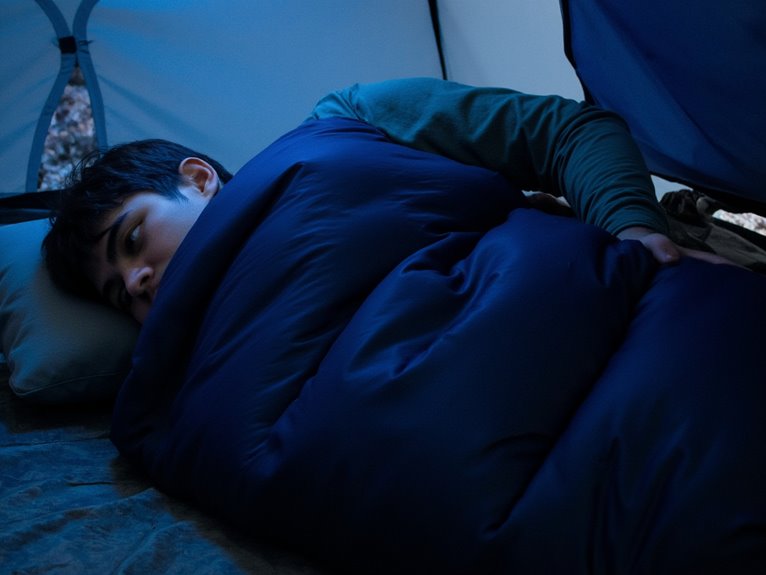The Incredible Benefits of Trekking Poles: Enhance Your Hiking Experience
Trekking poles elevate hikes by improving posture, alleviating joint strain, and enhancing balance. With poles, my body stays upright, engaging core muscles for stability, reducing back pressure. Impact on my joints decreases, especially during descents, benefiting knee health. Caloric burn increases by up to 20% as poles involve the upper body, turning it into a full-body workout. Core muscles strengthen, enhancing overall stability and balance. Poles distribute weight, decreasing stress on joints. Using trekking poles enriches my hiking adventures through improved posture, balance, and reduced strain, leading to a more enjoyable outdoor experience.
We are supported by our audience. When you purchase through links on our site, we may earn an affiliate commission, at no extra cost for you. Learn more. Last update on 7th January 2026 / Images from Amazon Product Advertising API.
Posture Improvement
When I hit the trails with my trusty trekking poles, I immediately notice how they effortlessly guide me towards a more upright and balanced posture. The poles serve as extensions of my arms, engaging my upper body and encouraging proper spinal alignment. With each step, I feel my core muscles activating as I consciously adjust my posture to walk in sync with the poles. This alignment not only reduces strain on my back but also promotes better breathing patterns, allowing me to take in more oxygen with each breath.
As I hike, the poles remind me to keep my shoulders back and down, preventing slouching and ensuring that my spine remains in a neutral position. This improved posture not only benefits my back but also helps in distributing my body weight more evenly, reducing fatigue on long treks. By actively involving my upper body in the hiking process, I find that I can maintain a steady pace with less effort, leading to increased endurance and enjoyment of the journey.
Impact Reduction
With every step on the trail, trekking poles play an essential role in substantially reducing the impact on joints, offering crucial support and stability to improve the hiking experience. The use of trekking poles can decrease the impact on joints by 3-5% with each pole plant, which greatly lessens the strain on knees, particularly during downhill descents. This decrease in impact not only minimizes the risk of injuries like sprains and fractures but also improves balance and stability on uneven and challenging terrain.
I can attest to the benefits of trekking poles in reducing knee strain and providing extra support. During my hikes, especially on rough paths or steep inclines, I have noticed a noticeable improvement in my stability and confidence when using trekking poles. The added support they offer allows me to navigate tricky sections with greater ease and less risk of stumbling or losing balance. This sense of security is crucial, particularly when tackling long trails or exploring unfamiliar terrains where every step counts.
Body Balance Enhancement
Hiking poles greatly improve body balance by involving upper body and torso muscles, promoting stability, and reducing strain on the lower back and knees during challenging terrains. When using trekking poles, the weight distribution shifts from being primarily on the legs to being shared between the arms and legs. This redistribution of weight eases the burden on the lower body, allowing for better stability and reduced strain on the joints.
By engaging the upper body and torso, trekking poles play a crucial role in enhancing balance. The act of planting the poles and propelling oneself forward requires coordination of various muscle groups, leading to a more balanced and stable hiking experience. This engagement not only reduces the load on the lower back and knees but also strengthens the core muscles, further enhancing overall body balance.
The continuous use of trekking poles reinforces proper posture and alignment, key factors in reducing strain on the lower body. As I hike with trekking poles, I feel more grounded and supported, especially on uneven terrain. The poles act as extensions of my arms, providing additional points of contact with the ground and enhancing my stability and confidence while traversing challenging trails.
Caloric Burn Boost
Increasing the calorie burn during hikes, trekking poles provide a valuable boost to overall energy expenditure and fitness levels. When using trekking poles, the experience is not only about the stability and balance they offer; it’s also about the extra effort they demand from your body, resulting in a more intense workout. Here’s how trekking poles can boost your calorie burn and improve your hiking experience:
- Increased Caloric Burn: Studies have shown that using trekking poles can boost calorie burn by up to 20% compared to hiking without them. The additional effort required to use the poles effectively engages more muscle groups, leading to a higher overall energy expenditure.
- Improved Oxygen Consumption: Trekking with poles boosts oxygen consumption as the upper body movement rhythmically complements the lower body stride. This increased oxygen intake fuels your muscles and improves the efficiency of your cardiovascular system, resulting in a more significant calorie burn.
- Upper Body Engagement: The added upper body engagement from using trekking poles not only helps with balance but also contributes significantly to the calorie burn. Pushing and pulling on the poles engages your arms, shoulders, and core, turning your hike into a full-body workout.
- Aiding Weight Loss Goals: By incorporating trekking poles into your hiking routine, you can effectively increase the calories burned per hike. This boost in energy expenditure can assist in achieving weight loss goals and improving overall fitness levels, making your hiking experience more rewarding and beneficial.
Core Strengthening
Engaging core muscles while utilizing trekking poles provides a dynamic way to strengthen your midsection and improve overall stability during hikes. Trekking poles actively engage upper body muscles such as the triceps and biceps, contributing greatly to core strengthening. As I hike with my trekking poles, I can feel my abdominal muscles working more efficiently than when hiking without them. This targeted workout not only boosts my core muscle strength but also helps in improving the appearance of my abdominal muscles over time.
The act of trekking itself challenges the core muscles, but when combined with the deliberate use of trekking poles, the intensity of the workout increases. The poles require a coordinated effort from the entire body, with the core muscles playing a vital role in maintaining balance and providing stability and support. This engagement of the core while using trekking poles has the potential to bring noticeable changes in core muscle strength over time, leading to improved overall body stability.
Incorporating core strengthening exercises into my hiking routine with trekking poles has not only improved my hiking experience but has also brought about tangible improvements in my core muscle strength and stability.
Joint Stress Reduction
During my hikes, I’ve found that trekking poles offer significant relief to my joints, especially when descending steep trails. These poles effectively distribute weight, reducing the strain on my knees by up to 25% according to studies. Engaging my upper body muscles with trekking poles not only boosts my stability but also lessens the impact on my lower body joints, making each step more comfortable and sustainable.
Decreased Impact on Joints
Reducing joint stress and promoting healthier joint function, trekking poles play an essential role in minimizing the impact on joints during hiking activities. By using trekking poles, the strain on joints is decreased considerably, enhancing the overall hiking experience and ensuring better joint health. These poles excel in absorbing shock and distributing the weight of the body, thereby decreasing the pressure on joints like hips, ankles, and knees. Studies have shown that trekking poles can diminish compressive force on the knees by up to 5 kg with each step, showcasing their effectiveness in joint stress reduction. Additionally, during descents, these poles can lower the load on knees by up to 30%, making them indispensable for maintaining joint health during challenging terrains.
- Trekking poles reduce impact on joints by 25% on flat ground and up to 75% on inclines, decreasing stress and strain.
- Studies have shown that using trekking poles can reduce compressive force on the knees by up to 5 kg with each step, promoting joint health.
- Joint stress reduction with trekking poles is particularly beneficial during descents, where poles can reduce the load on knees by up to 30%.
- Trekking poles help distribute the weight of the body more evenly, reducing strain on joints like hips, ankles, and knees during hikes.
Improved Stability and Balance
By utilizing trekking poles, one can quickly observe an improvement in stability and balance on different terrains, leading to the decrease of joint stress and encouraging a safer hiking experience. When walking with trekking poles, the additional points of contact with the ground provide improved stability, especially on uneven or slippery terrain. This increased stability reduces the risk of falls and helps maintain proper posture, minimizing strain on joints. The poles act as extensions of your arms, allowing for better weight distribution and support, decreasing pressure on knees, ankles, and hips. Studies have shown that using trekking poles can reduce joint stress significantly, with up to a 25% decrease in strain on knees and ankles, and a 15% decrease in strain on hip joints.
Stability and Support
How do trekking poles improve stability and support during hikes on challenging terrains?
Trekking poles are not just accessories; they are essential for enhancing stability and support while trekking. Here’s how they make a substantial difference:
- Weight Distribution: Trekking poles help distribute weight evenly, reducing strain on the legs, knees, and ankles. This balance guarantees you can tackle steep inclines and declines with more ease and less impact on your joints.
- Impact Reduction: Studies have shown that using trekking poles can decrease the impact on joints by 3-5% with each pole plant. This decrease in stress on your joints can make a huge difference, especially during long hikes.
- Enhanced Balance: Think of trekking poles as extra legs that provide additional balance and stability on uneven terrains. They act as anchors, preventing slips and falls, allowing you to navigate tricky paths with confidence.
- Posture Support: Proper posture is essential during hikes to avoid fatigue and discomfort. Trekking poles promote good posture by encouraging an upright stance, which can prevent back strain and muscle fatigue, particularly on extended treks.
Trekking poles are not just for show; they are indispensable tools that contribute significantly to your hiking experience by providing stability, support, and ensuring your joints and body are well taken care of on challenging trails.
Hiking Experience Enhancement
Trekking poles not only provide stability and support but also greatly improve the overall hiking experience by offering numerous benefits that heighten the enjoyment and effectiveness of your trek. In terms of stability, these poles act as an extra set of legs, especially on challenging terrain, reducing the risk of falls and injuries. By aiding in weight distribution, trekking poles help alleviate strain on joints like knees and ankles, making your hike more comfortable and sustainable.
Additionally, the use of trekking poles engages your upper body muscles, providing an unexpected but welcomed full-body workout as you trek along. This added physical engagement not only boosts calorie burn but also contributes to better overall fitness. Moreover, these poles can boost your hiking speed and endurance by improving your balance and propulsion, allowing you to cover more ground with less effort.
Furthermore, trekking poles promote better posture, which is essential for reducing fatigue and preventing strain on your back and shoulders during long hikes. By maintaining proper alignment, you’ll feel more energized and experience less discomfort, ultimately making your hiking adventure more enjoyable and efficient.




